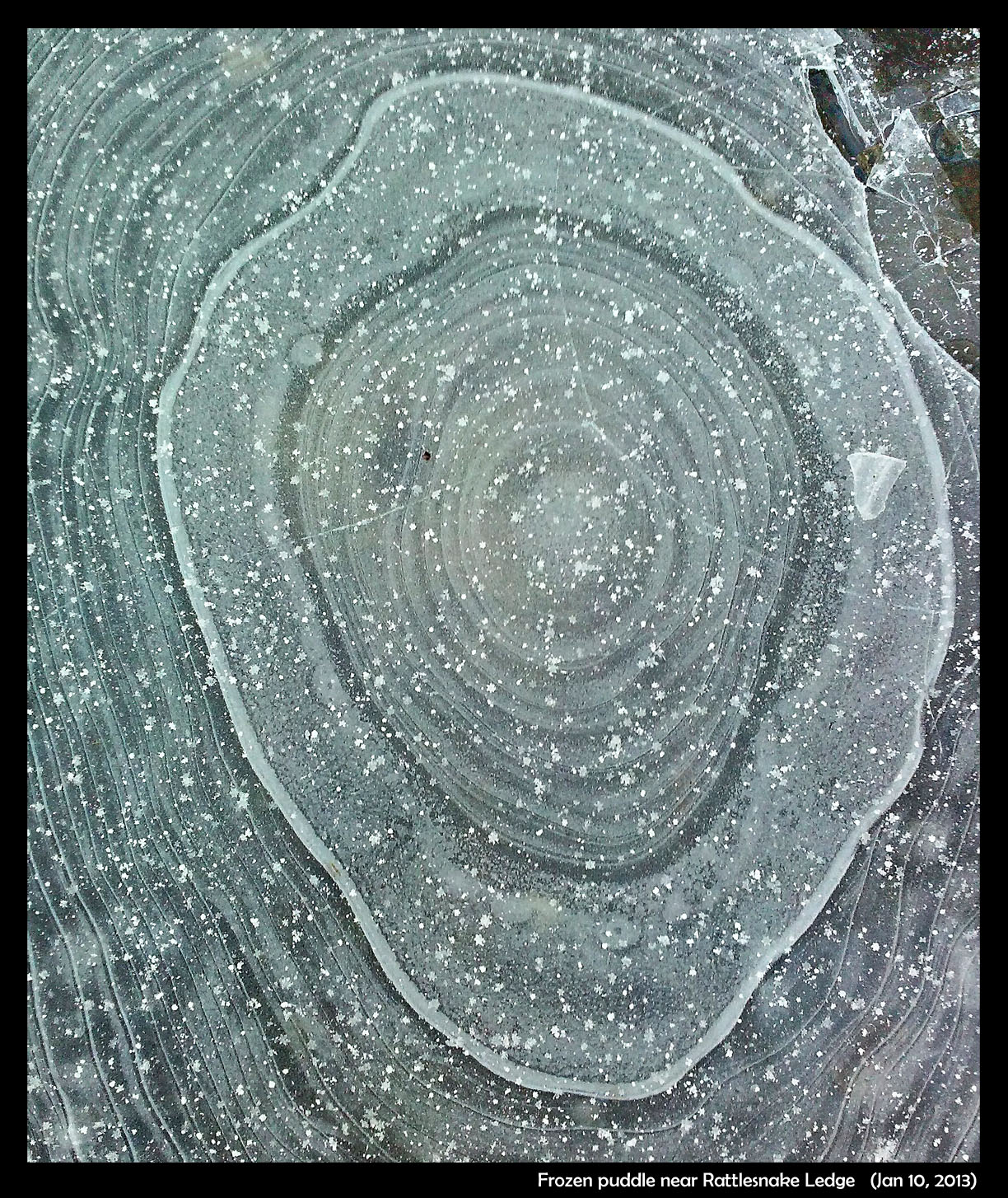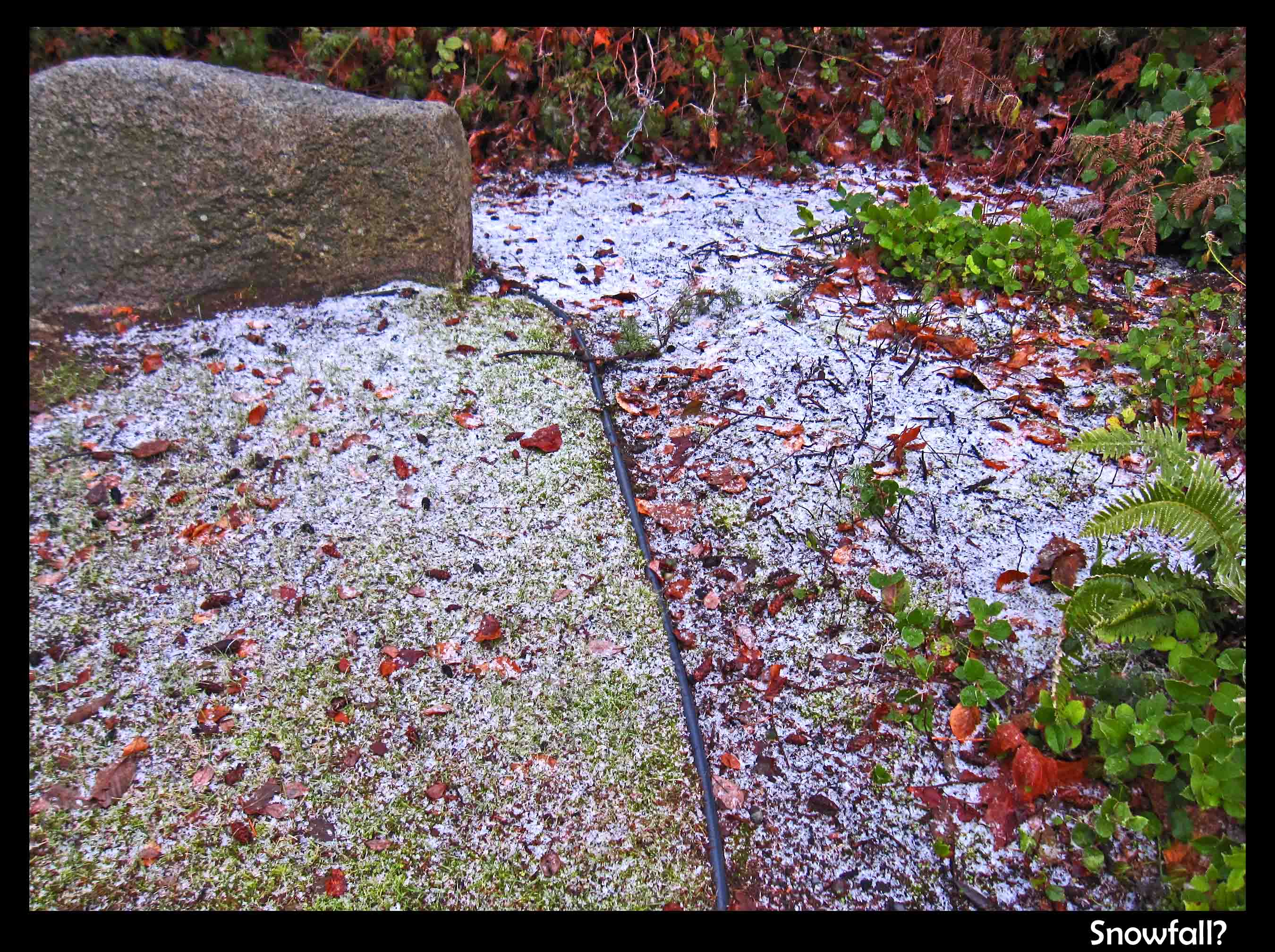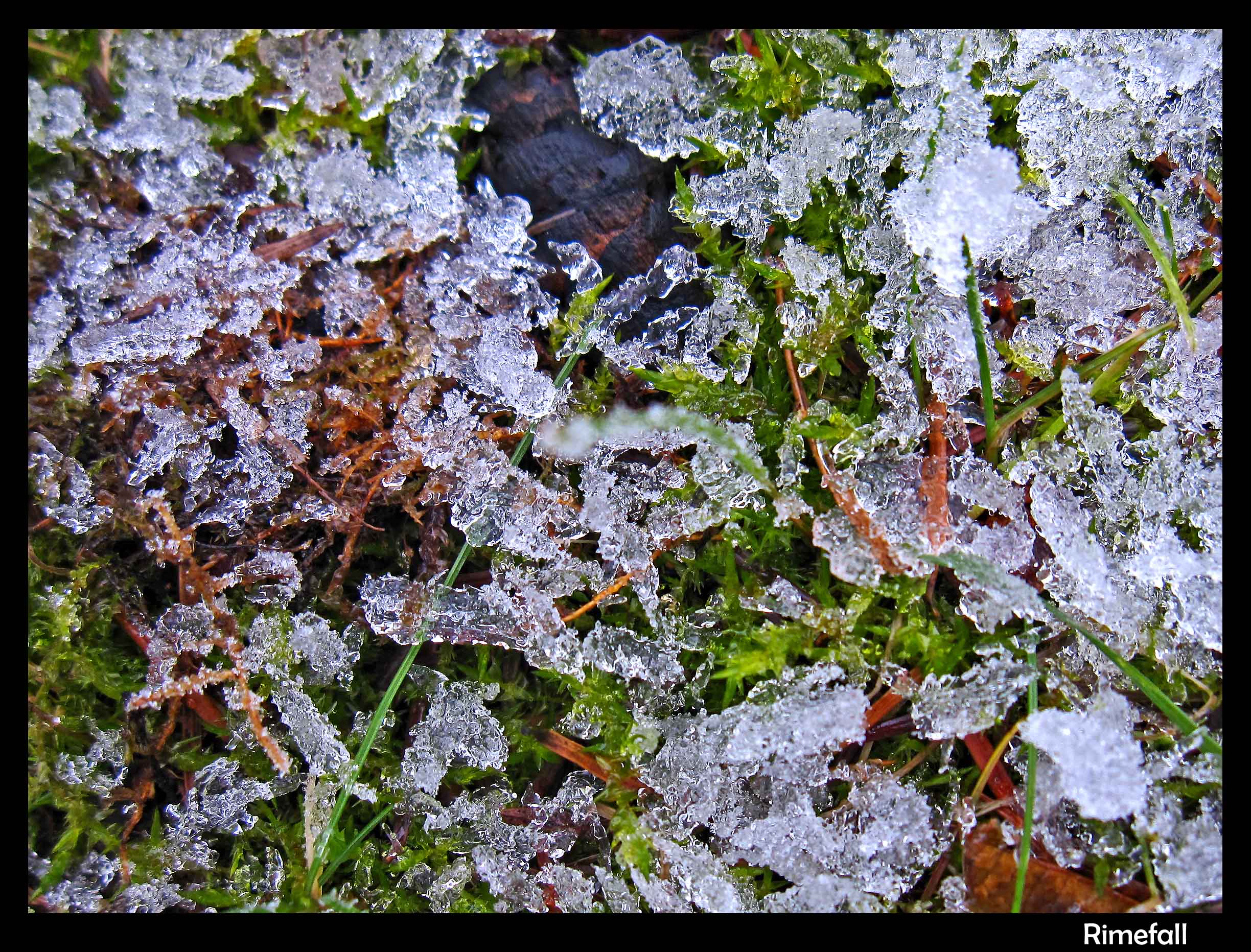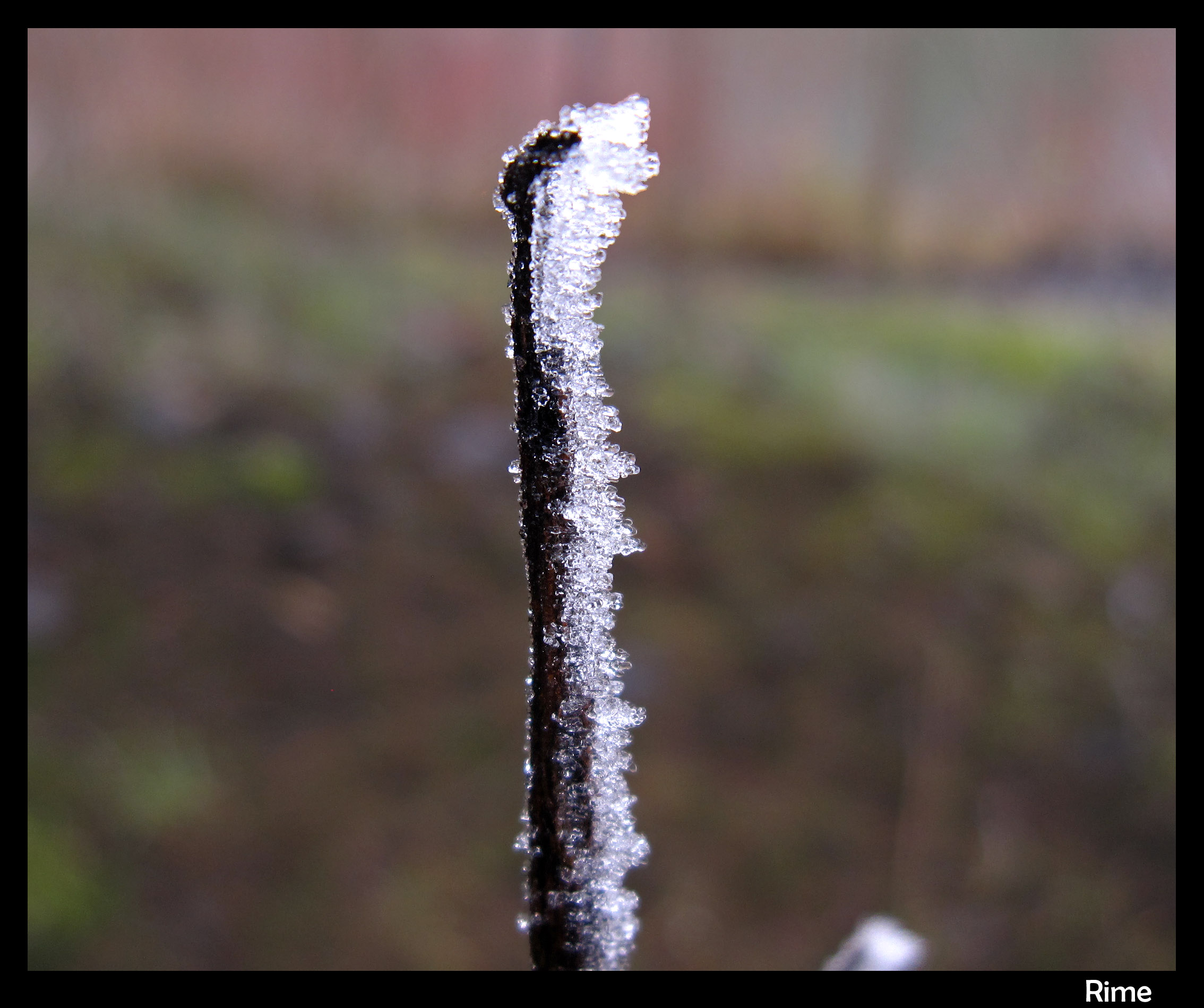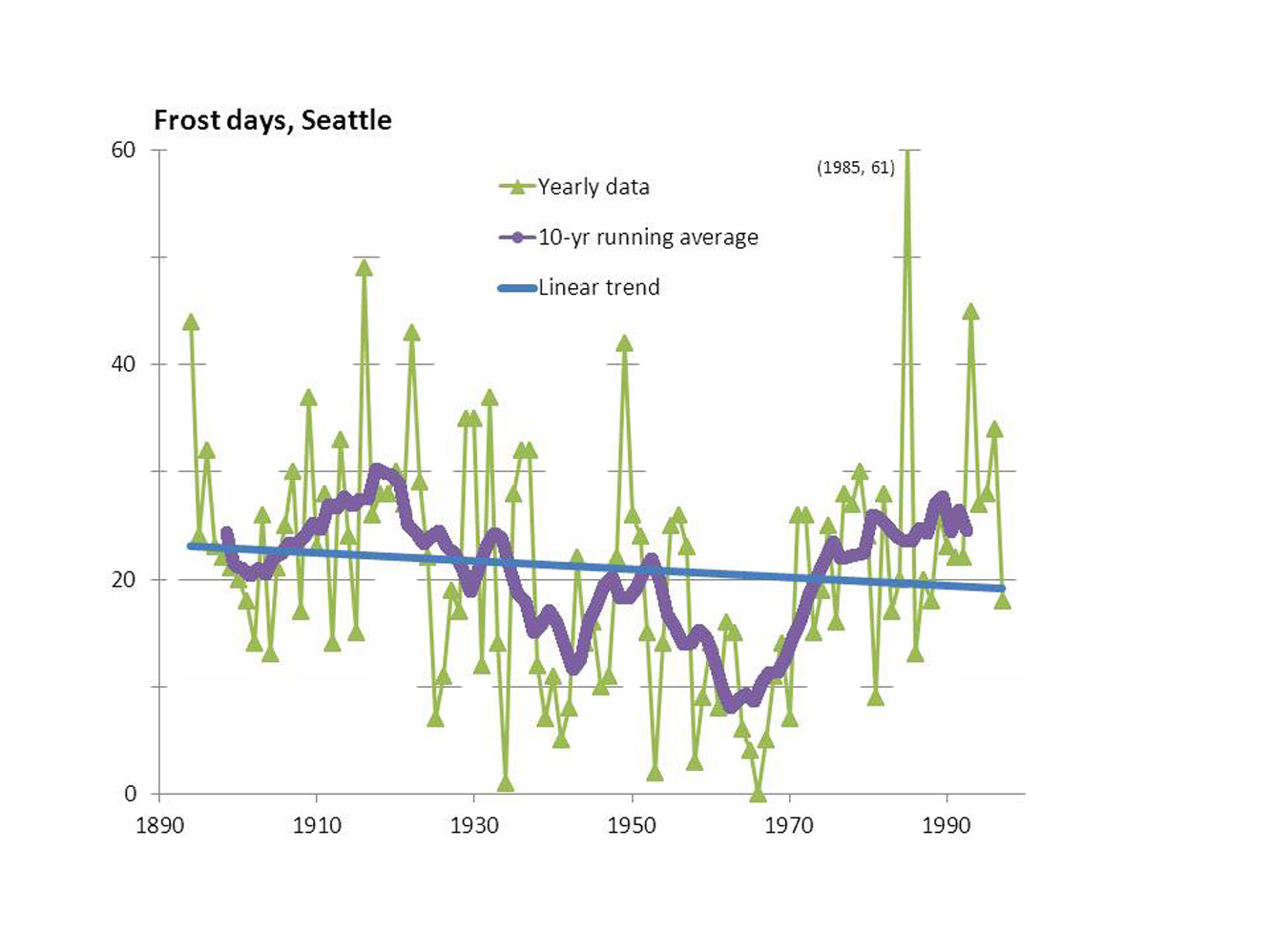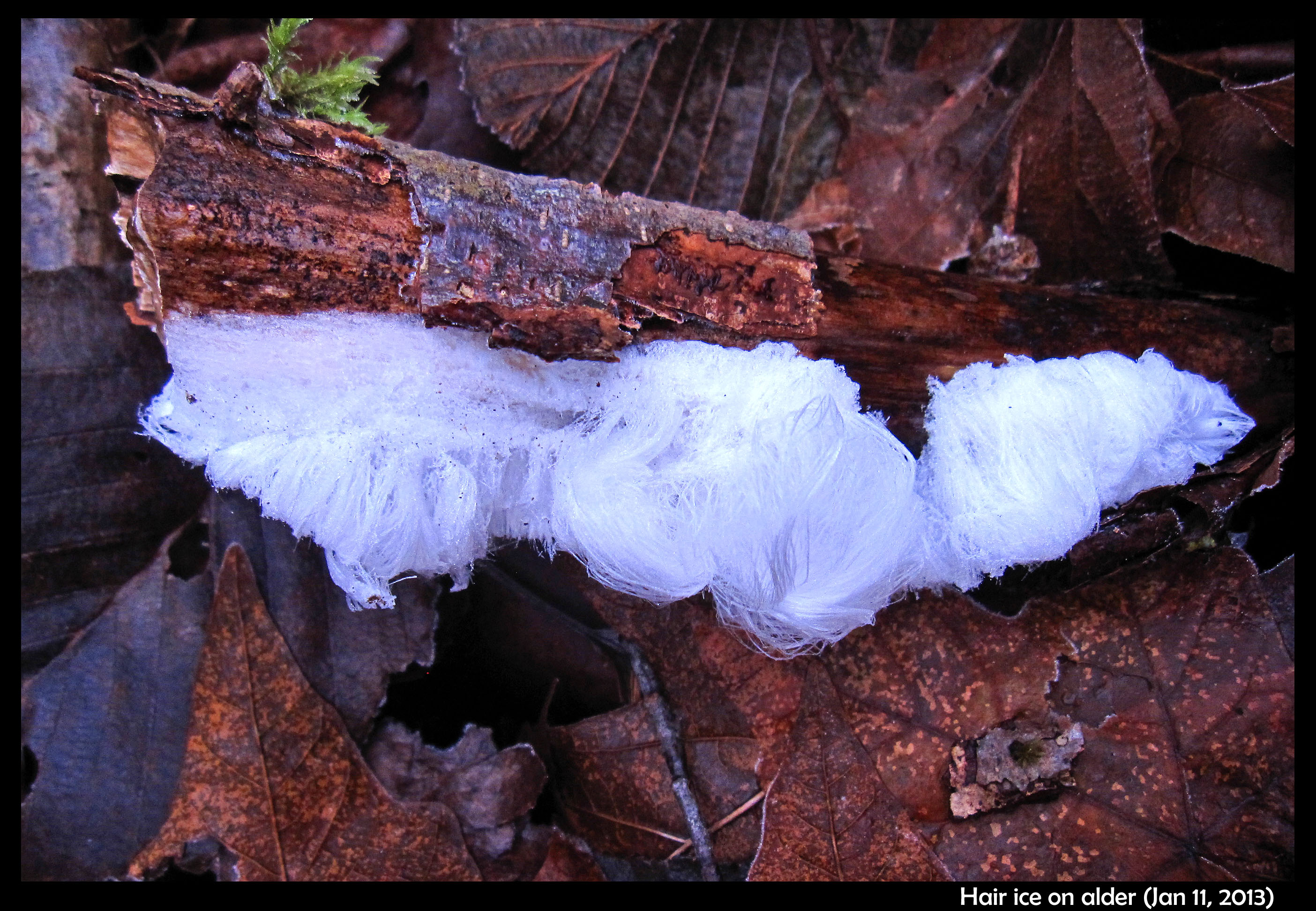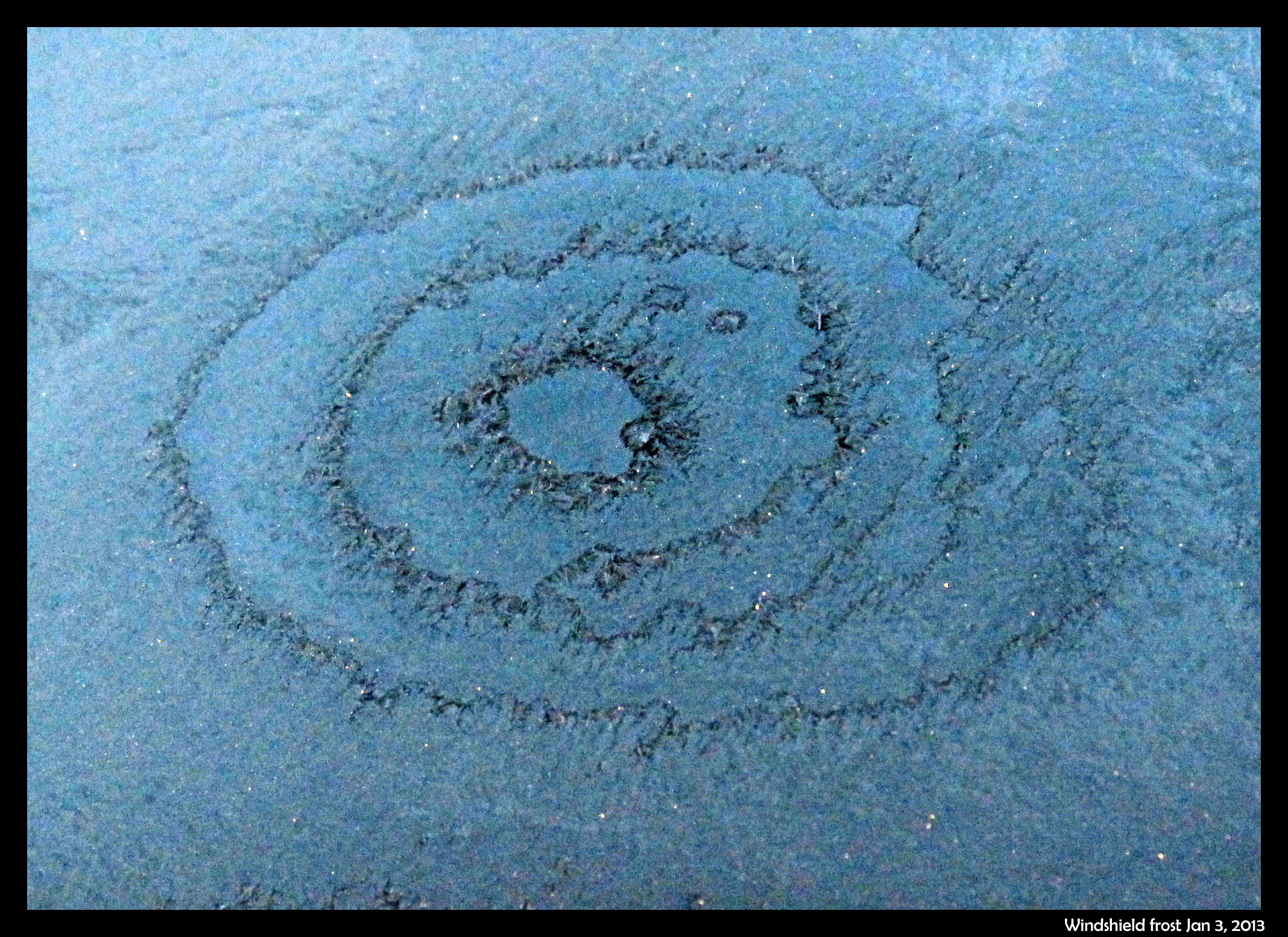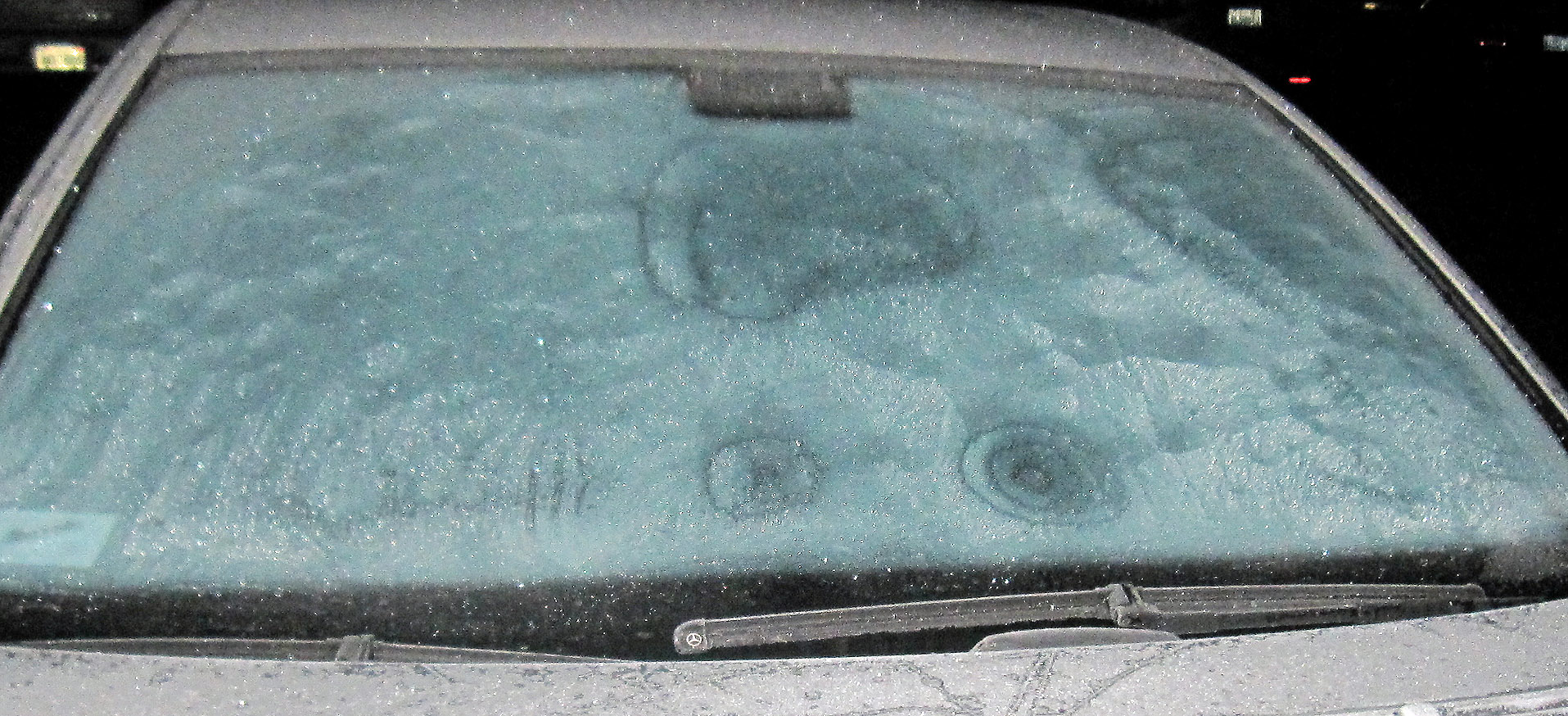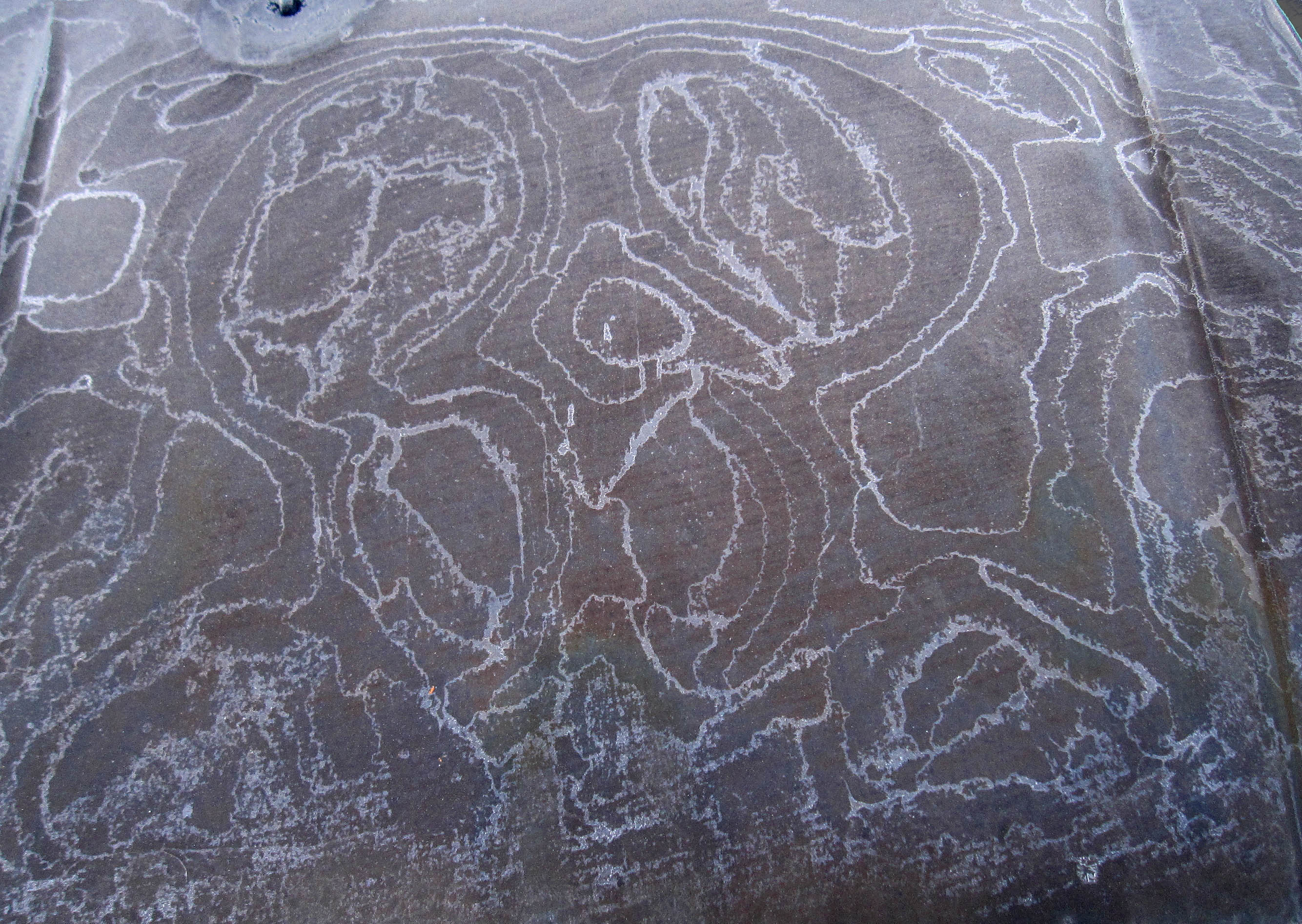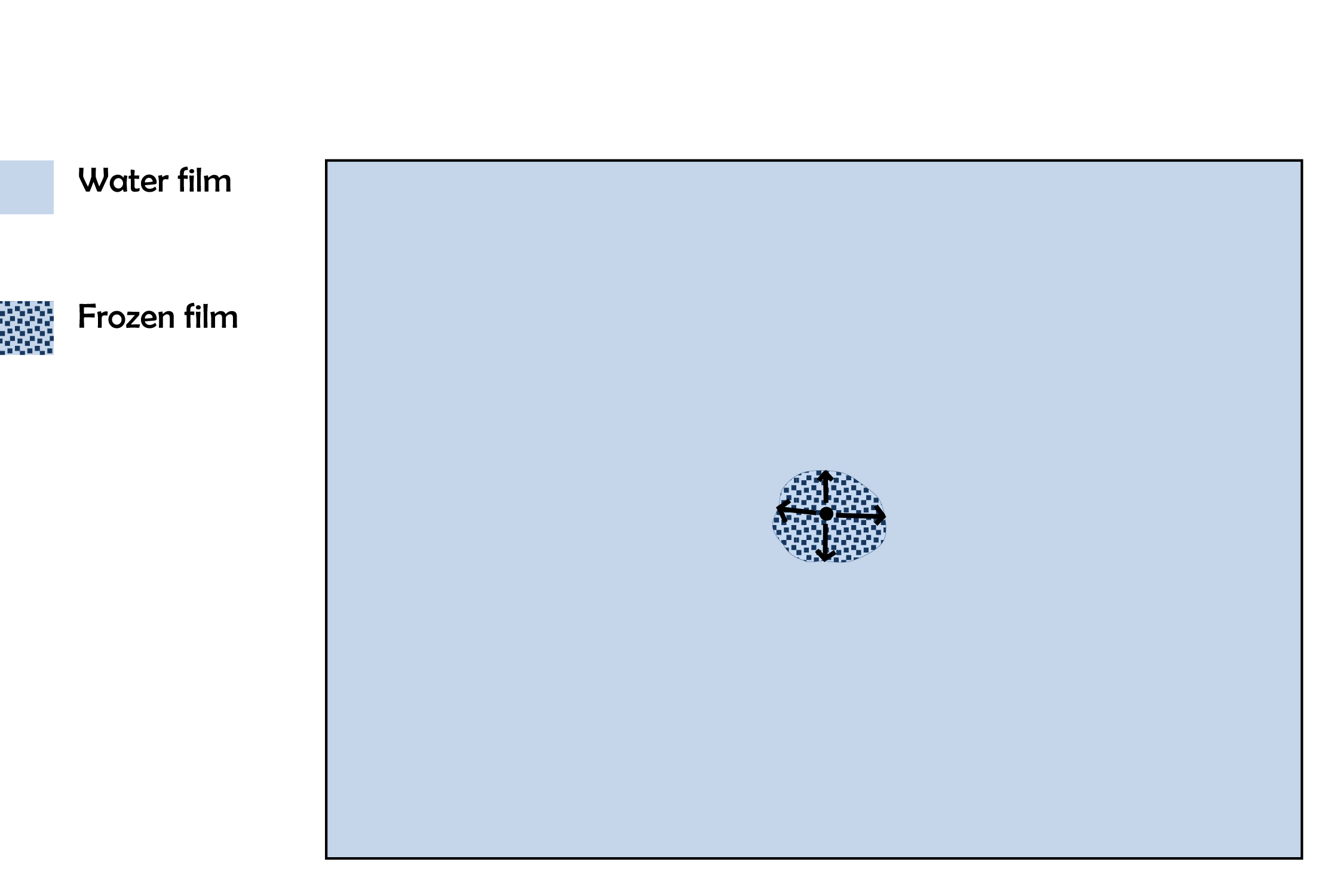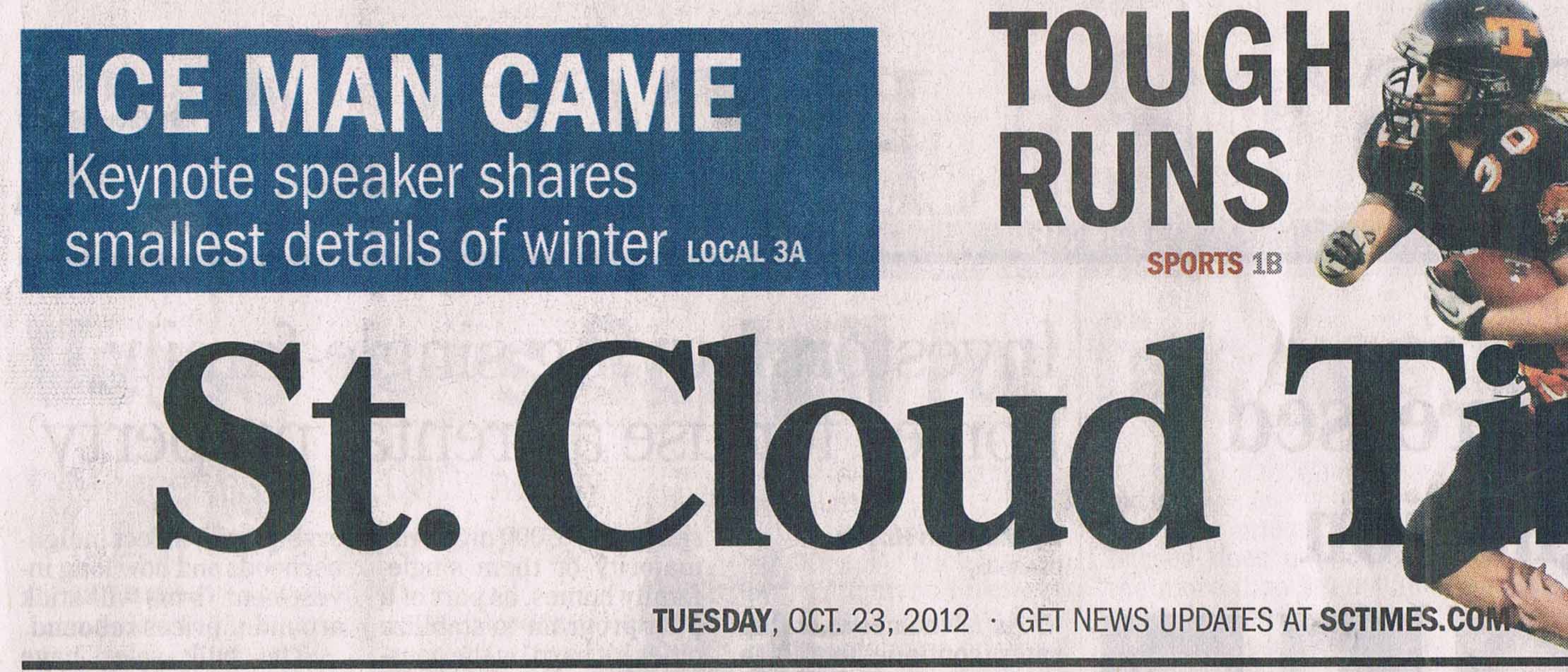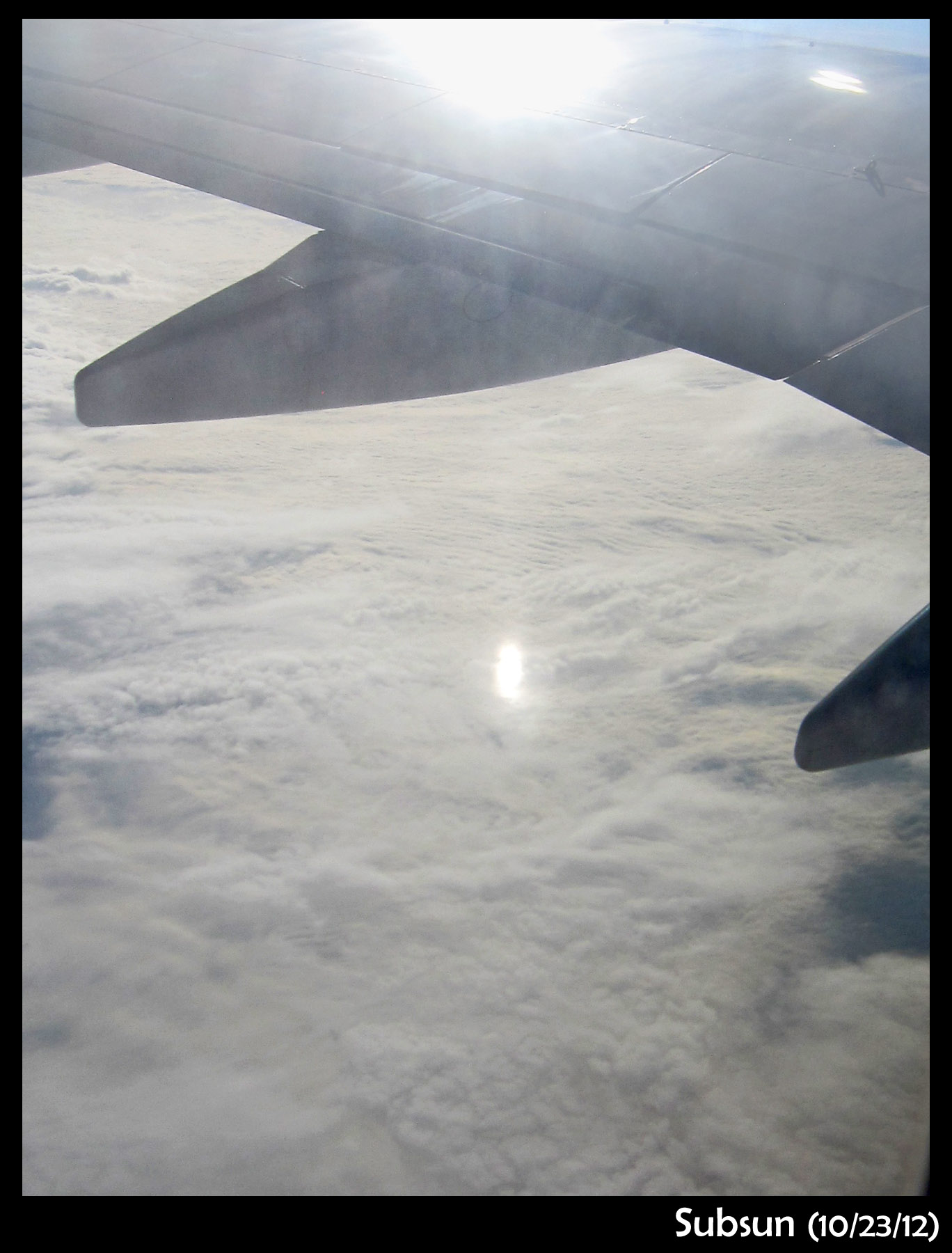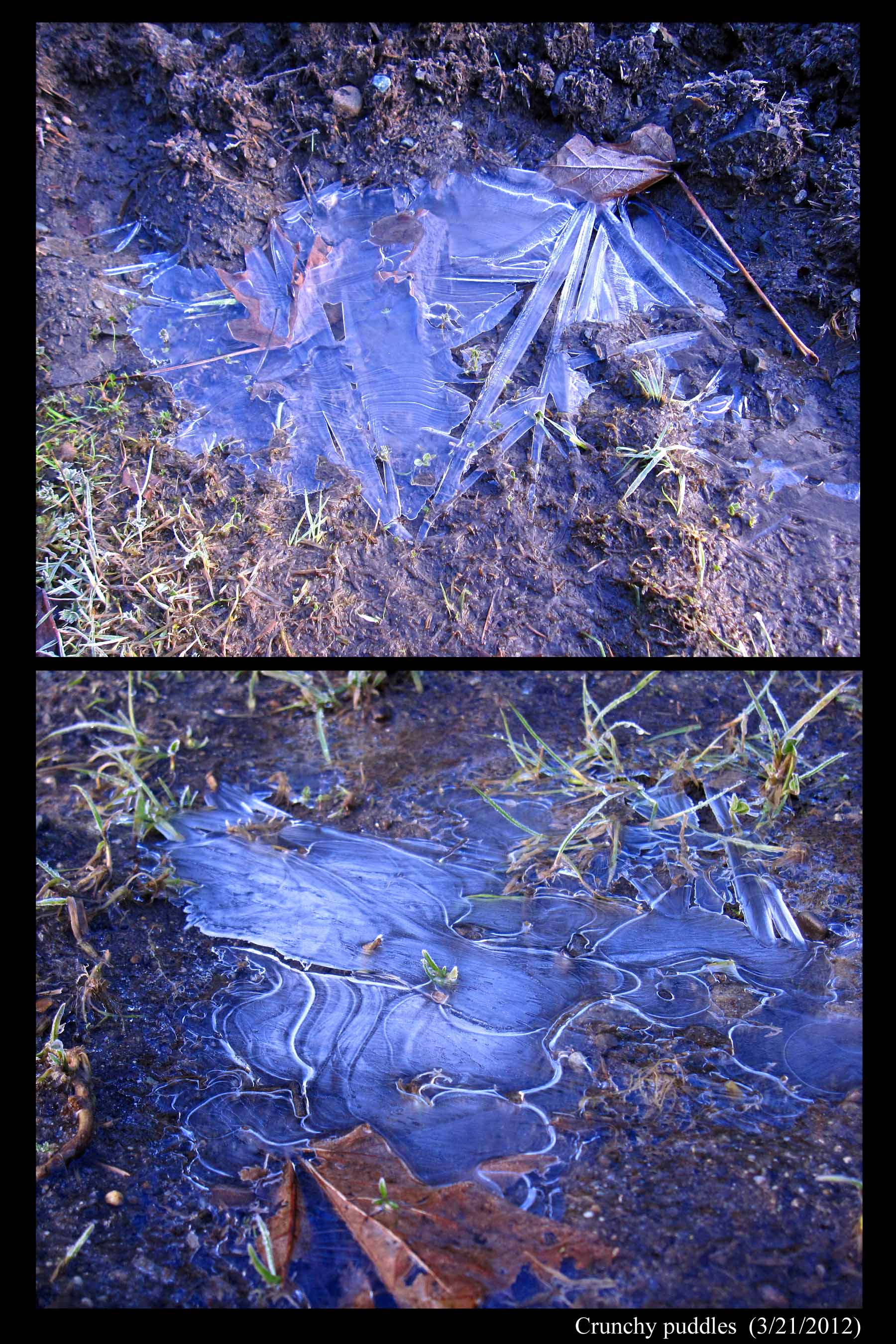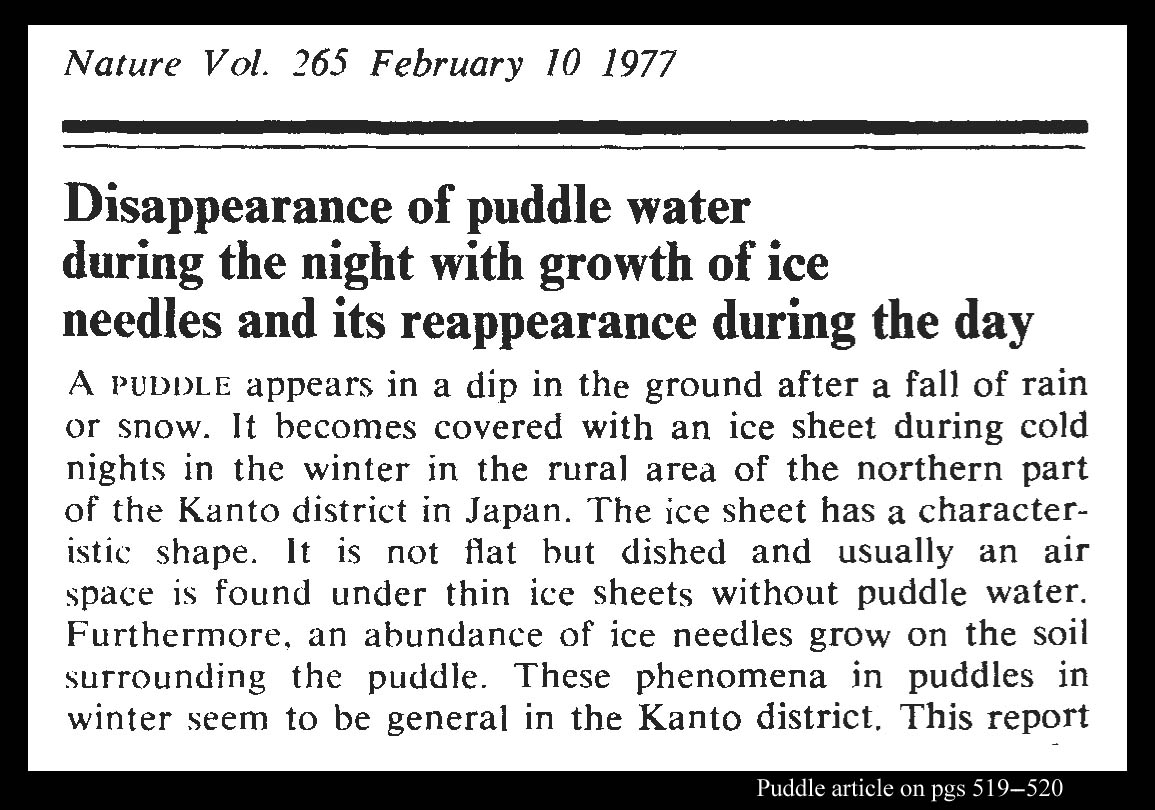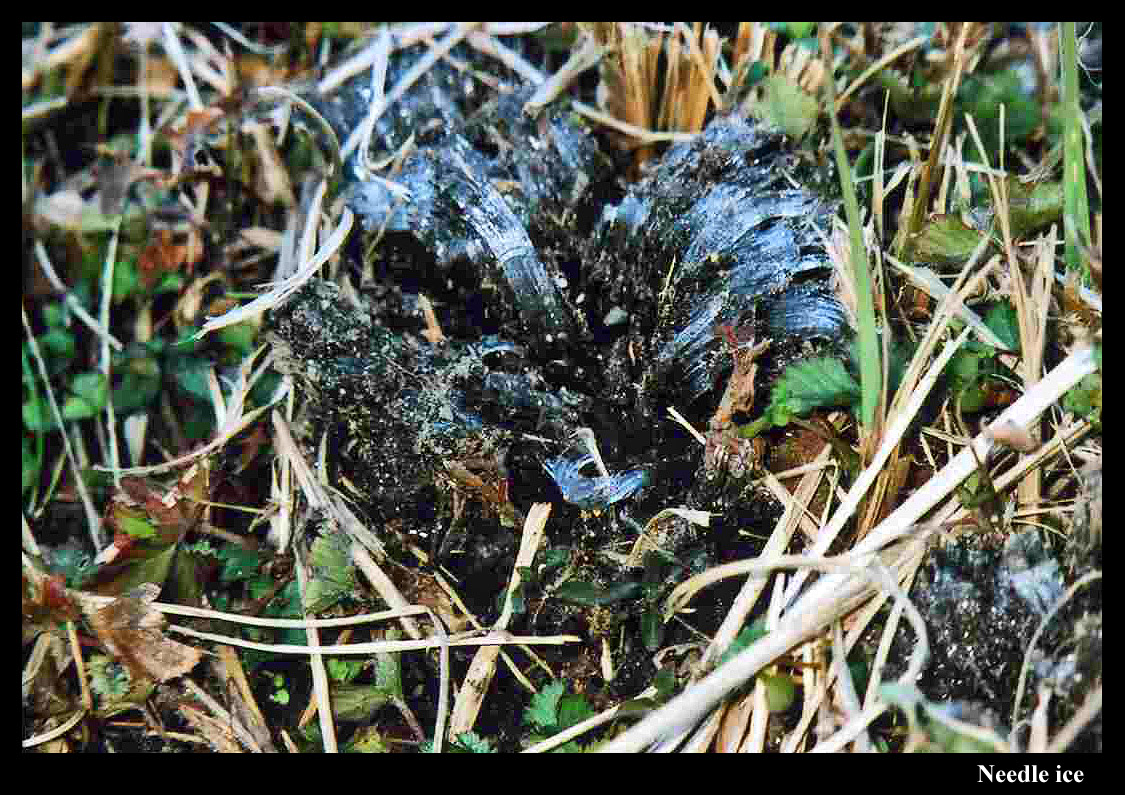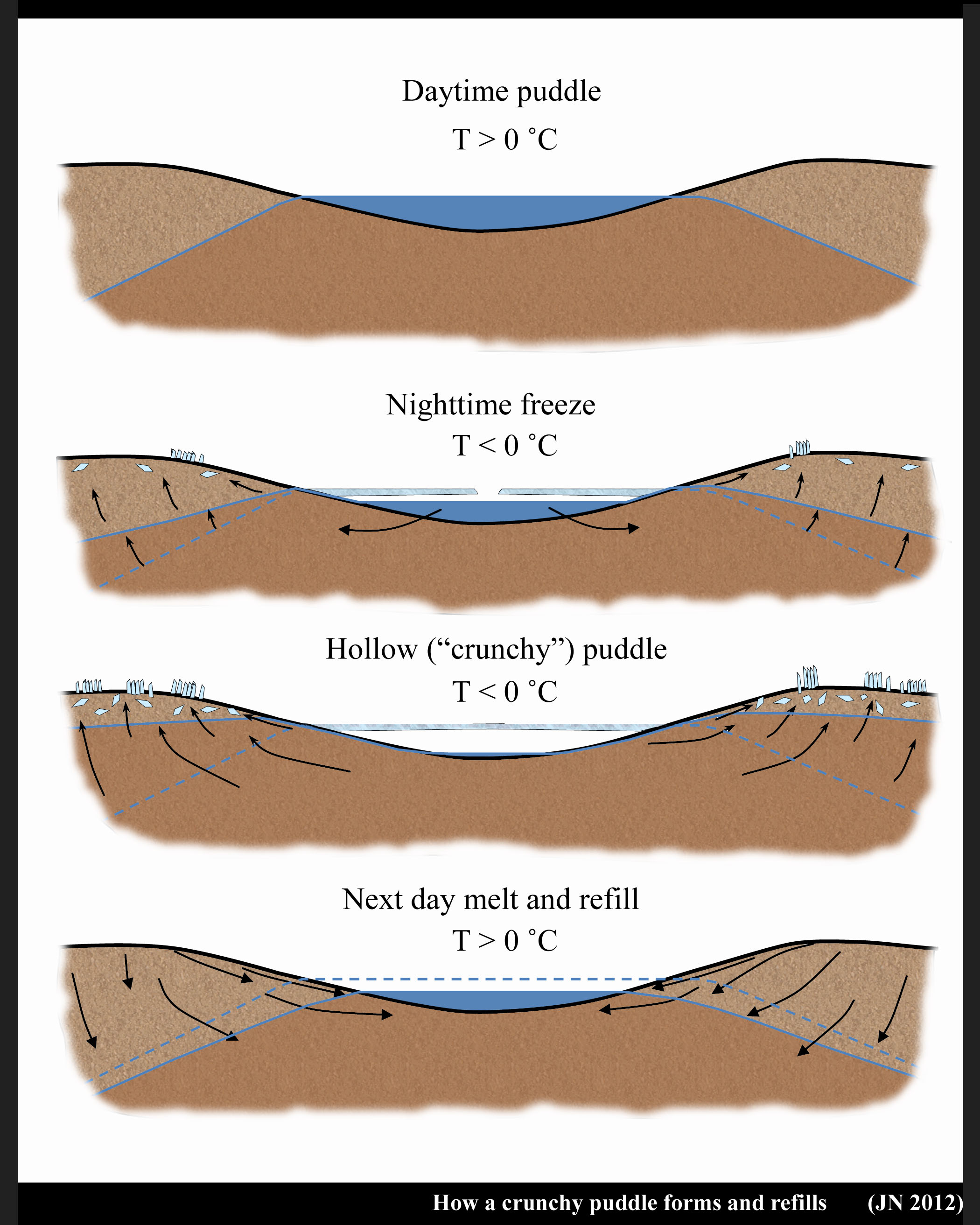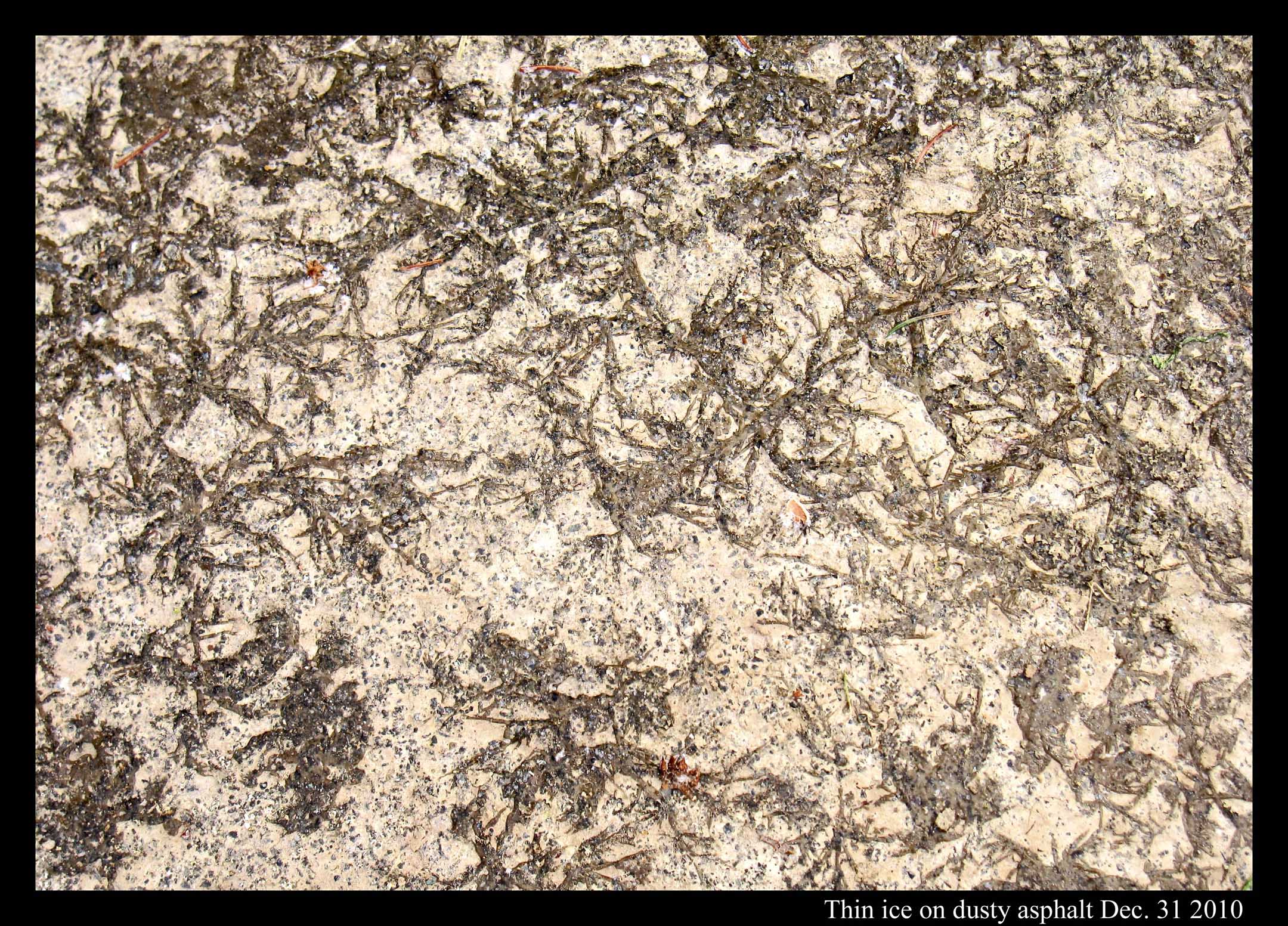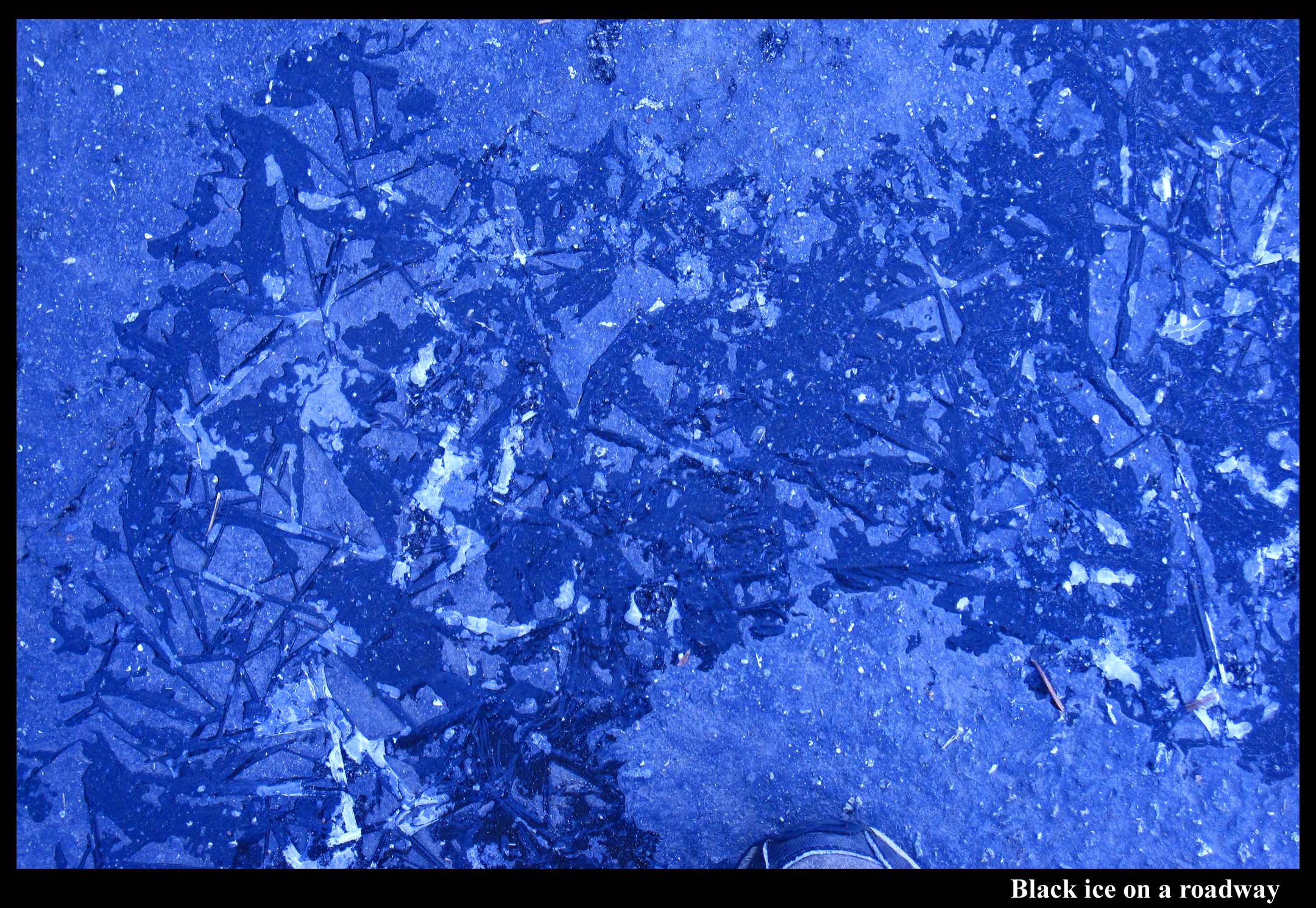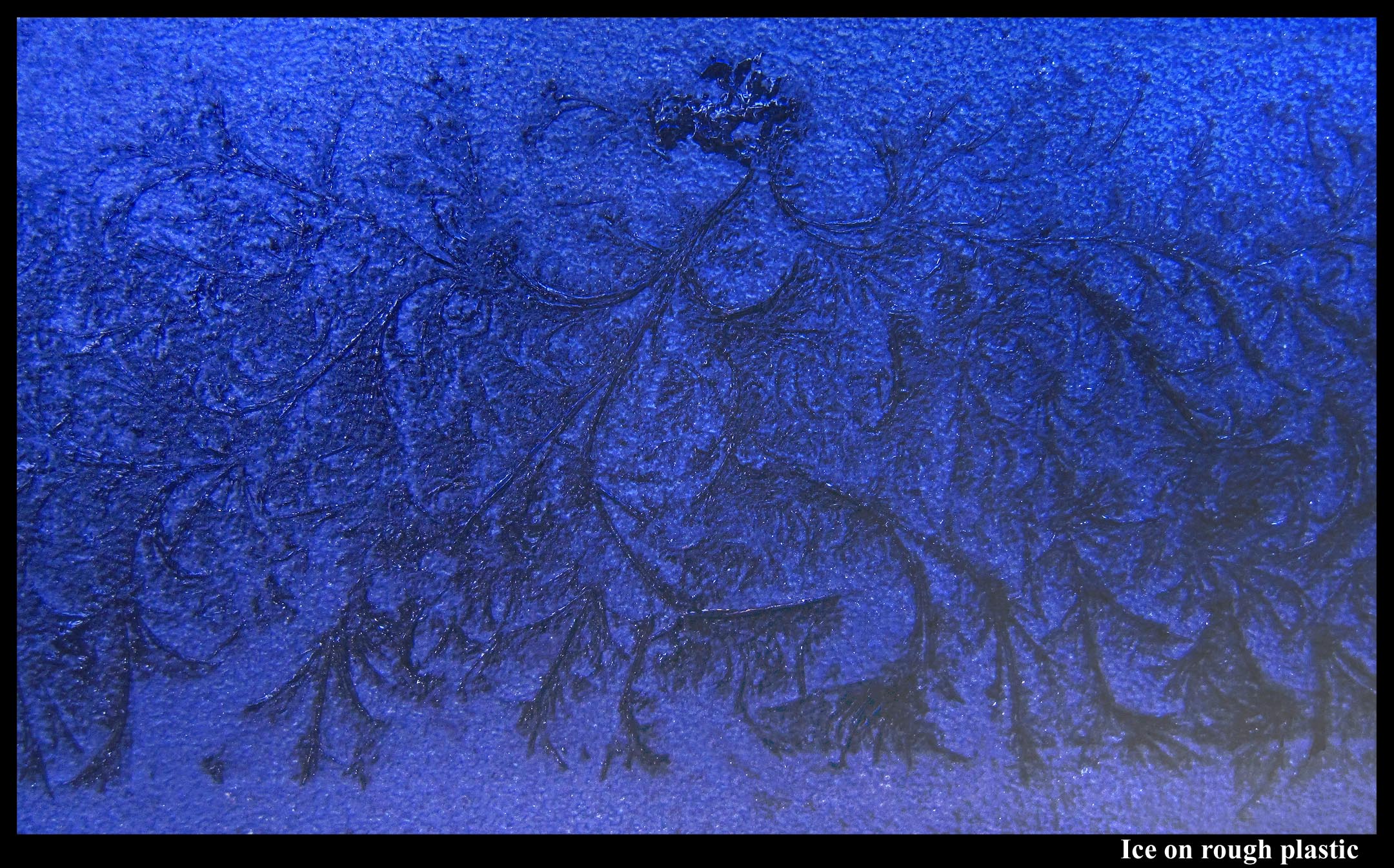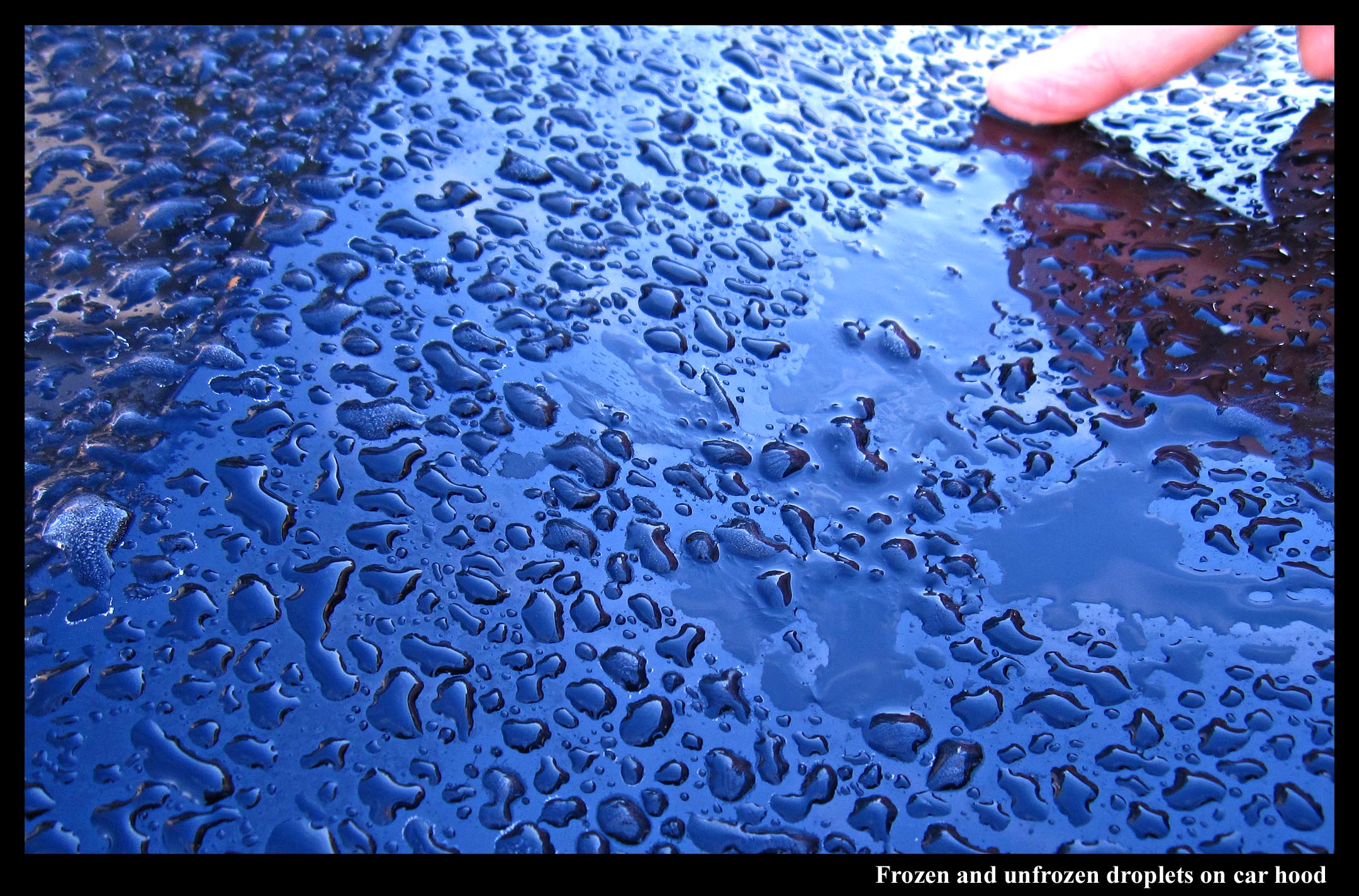What makes the thick curvy lines in frozen puddles?
January 27th, 2013My sister recently sent this photo of a frozen puddle, a little over a foot across. Something broke out a piece of ice in the upper right, but it’s mainly a complete glaze over the top. (The white dots are rimed snow crystals. Click to zoom in and see.)
Notice how it has drained – the light color is due to the air underneath. The lines are roughly concentric with the shape of the puddle, though there can be considerable variation. On larger puddles or ponds, you might just see these thick curvy lines just near the shoreline.
Rime falling from branches
January 24th, 2013While riding my bike home the other day, I saw what appeared to be a patch of light snow.
It was the only such patch around. Looking closer, I could see that it consisted not of snow, but of chunks of partly melted rime deposits. (Note how the pieces are long and narrow, like little icicles.)
Just above were the branches of a huge Douglas Fir tree. Perhaps there had been an over-active squirrel or two up there. Other trees still had their rime. Hard to see why only this tree would have its rime fallen off.
- JN
Rime, freezing fog, and crystalline spider webs
January 22nd, 2013The Pacific Northwest has been foggy a lot lately, but the fog droplets have been subzero, or supercooled. When such fog droplets hit an object, they almost always freeze. The resulting frozen aggregate is called rime. Freezing fogs make rime.
The resulting rime formations may look like hoar frost, or even snow, from a distance. But close up the special features of rime become apparent.
Frost Days and Ice Days: Declining Numbers over the Century
January 17th, 2013David Easterling recently reported in BAMS** that the number of frost days per year is decreasing over the US. A frost day is a day in which the minimum temperature goes below the melting temperature of ice (32 F or 0 C). This doesn't sound good for a frost observer like me. Moreover, the largest decrease, a value of 2.6 fewer days per year per decade, is in my area, the Pacific Northwest. Will frost soon be a threatened species?
His analysis and presentation was based on 1948-1999 data, and moreover, he averaged over multi-state regions. I'm more interested in my local area, King County, Washington, and would like to see both the longer-term trend and variability. I quickly sent him an email, requesting more info. But I was impatient and sought the raw data myself. Following the info in his article, I found the data online***. An added plus: at many stations, the data now goes back another 50 years. With a few simple commands typed into an Excel spreadsheet, I determined the longer-term trend for a station near the University of Washington stadium in Seattle (the only such site in Seattle).
Hair Ice on Wood and Pavement
January 16th, 2013The morning after a rapid cool-down, I found hair ice on an alder log.
From a distance, it looked unnaturally white, like it was a bit of discarded cotton or white paper, but the closer I got to it, the more incredible it seemed.
Crystal-to-crystal “communication” through vapor and heat
January 5th, 2013Two mornings ago, I saw this on the windshield of a parked car.
The bulls-eye pattern wasn’t centered on any particular feature on the windshield, and there were similar, though less developed, patterns nearby. See them on the photo below.
The dark parts are largely frost-free regions, and thus are regions that dried out during the crystallization event. (It was still dark when I took the shots.) Later, under a brighter sky, I saw a different pattern on the hood of another car, a pattern that I figure has a similar cause. In the hood case, shown below, the dry regions are bright due to reflection of the sky.
Now, about those concentric rings …
I puzzled over a larger such pattern in the Feb. 5, 2010 posting “Ripples”. The causative process that I proposed back then seems consistent with this newer observation, but I will clarify it here.
Before the first frost formed, the windshield, though seemingly dry, nevertheless had a thin layer of liquid water. This thin film had cooled to some temperature below freezing. (See the sketch “How hoar frost forms” in the Jan. 11, 2012 posting.) As the windshield and water film continued to cool, freezing was inevitable; the only issue was where. The first such spot to freeze must have had some feature, however minute, that was advantageous to freezing. It may have been a nucleant particle (e.g., a mineral dust grain, a type of bacteria, or even a tiny fleck of ice that wafted in from somewhere else), a slightly cooler spot, or a slightly thicker water film (e.g., from a scratch or indentation). But for whatever reason, the ice formed there first.
Now suppose the ice spreads outward from the nucleation spot in all directions with about the same rate. I suspect this happens when the film is extremely thin, as it would have been under the relatively dry conditions of this day. So, the frozen film grows outward, roughly as a disc. See the sketch below; the black dot in the center is the first place that froze.
Trip of the Ice Man
November 9th, 2012
The "Ice Man" -- that's how a newspaper header referred to me after I gave a recent conference lecture:
A link to the article is here:
http://www.sctimes.com/article/20121023/NEWS01/310230011/Featured-speaker-details-snow-crystals-SCSU-storm-conference
It was a very enjoyable visit to the 7th annual Northern Plains Winter Storms Conference on the campus of St. Cloud State University in St. Cloud, Minn. We had various talks including one about forecasting a storm, the statistics of the snow-to-liquid equivalent ratio (e.g., in some areas about 13" of snow will melt to 1" of water, but regions and storms vary considerably, some being over 70 to 1),and one talk about how a late-season snowstorm might end a locust plague (unlikely, according to the speaker).
My talk described how a simple principle allows us to understand how a wide variety of snow crystal forms originate.
Here's the narrated talk. To view, click the image, then enlarge to full screen:
">
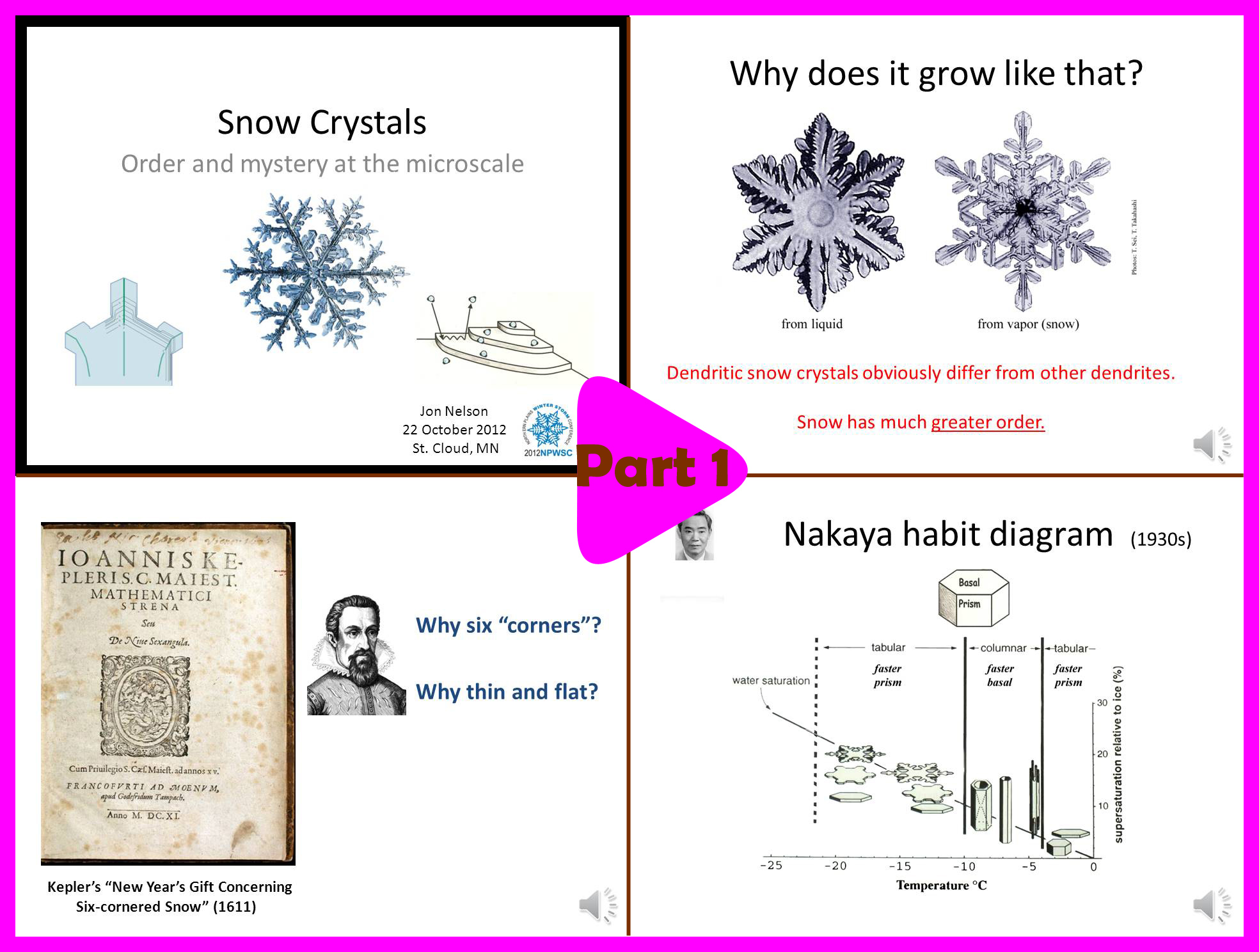
Part 1 (10 min):
-> Why study snow crystal shapes?
-> Some history about snow science.
-> The habit map.
-> Questions that will be answered in the rest of the talk.
">
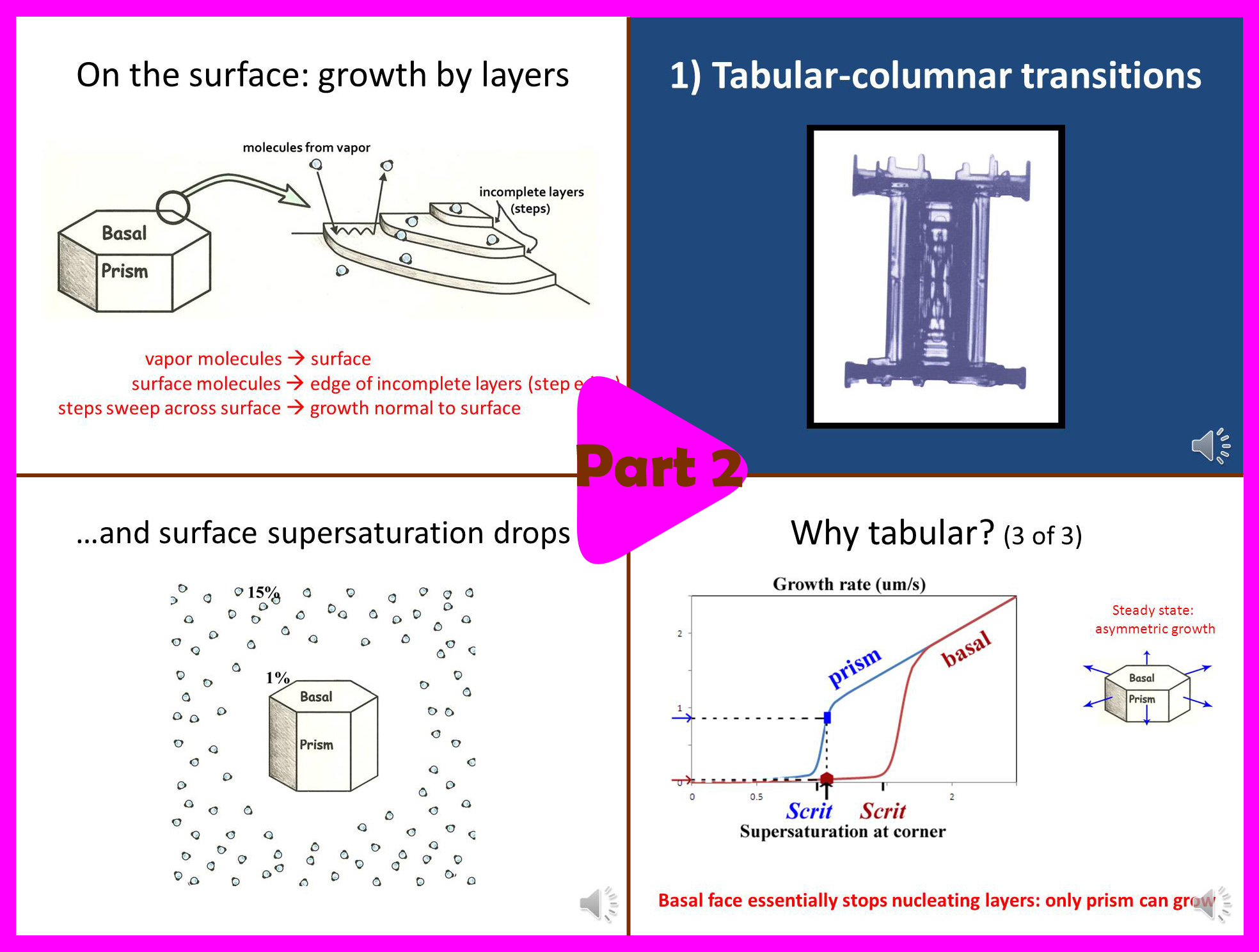
Part 2 (13.5 min):
-> Basics of snow crystal science.
-> Why dendrites grow so thin.
-> Why needles and columns sometimes form.
">

Part 3 (6 min):
-> How the crystals get their branches.
-> Why they are six-fold symmetric.
">
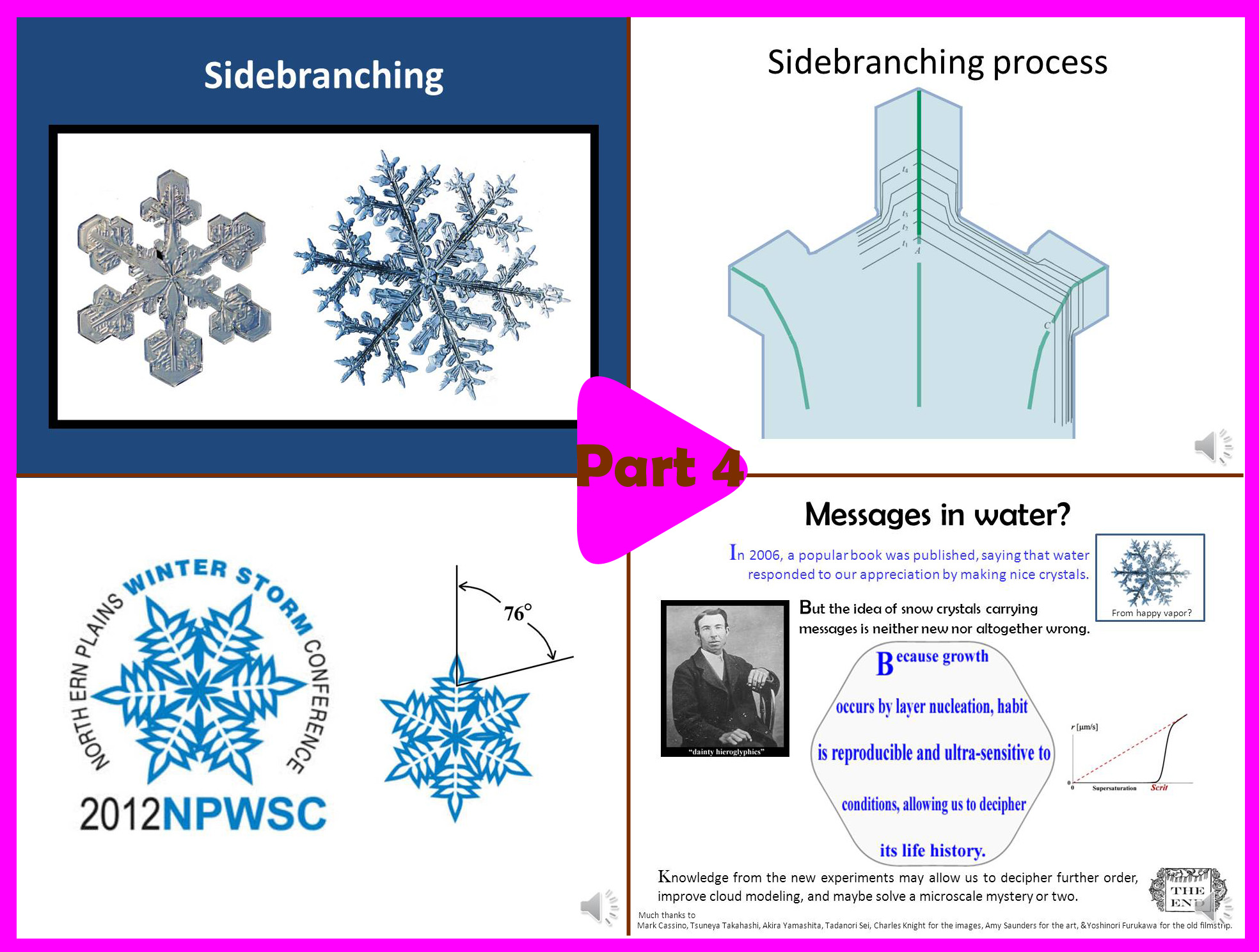
Part 4 (14.5 min):
-> How the crystals get sidebranches.
-> Common errors we make when drawing snow.
-> Why they have so much variety.
-> Mysteries about snow.
-> What are the "messages in water".
It is a scientific talk, so it involves some diagrams and technical terms. But this one is pretty easy. Perhaps the only technical terms are "vapor deposition" and "supersaturation". Vapor deposition happens when water molecules in the air (i.e. water vapor) crystallize onto something, like a snow crystal or hoarfrost. The vapor must be "super" saturated for this to happen. Greater supersaturation means greater vapor density and thus faster growth. The above link goes to the first segment, and from there you can click on the subsequent segments.
On the flight home, I saw a subsun on the clouds below. A subsun is a reflection of the sun from tiny, flat, hovering plate-like (tabular) ice crystals. They are essentially hovering like microscopic flying saucers.
In the photo above, you can see the sun's reflection off the wing on top. The smaller reflection on the clouds below is the subsun. I used to think the subsun was rare, but apparently I simply wasn't looking. This subsun was there in various forms for at least 2/3rds of the flight. I've seen them on most previous flights. More on subsuns in the next post.
- Jon
Here's the abstract to the talk:
snow crystal seminar abstract.pdf
And here are the four parts of the talk in pdf form (from the PowerPoint slides):
snow order and mystery - 1of 4.pdf
snow order and mystery - 2 of 4.pdf
snow order and mystery - 3 of 4.pdf
snow order and mystery - 4 of 4.pdf
2013 Louis J. Battan Award
November 3rd, 2012The Story of Snow has received the 2013 Louis J. Battan Award from the American Meteorological Society.
From the society's website:
The Louis J. Battan Author's Award - K-12
The Louis J. Battan Author's Award - K-12 is presented to the author(s) of outstanding, newly published learning materials or books that foster the understanding of atmospheric and related sciences in K-12 audiences. Nominations are considered by a committee of the Education and Human Resources Commission, which makes recommendations for final approval by AMS Council.
This is a great honor and Jon and I are both thrilled with this award!
From the AMS website:
The Crunchy Puddle Puzzle
March 24th, 2012Who cares about crunchy puddles?
As a kid, I liked to stomp on hollowed-out frozen puddles to hear their crunch. Sure, I sometimes wondered, as many kids probably do, about what happened to all the water and why it happened only to some of the puddles. But such puzzles don’t linger in the mind of a kid for long.
Years later, while living in Japan, I rediscovered frozen puddles and saw their beauty in new ways. I saw new puzzles and revisited the old one about the missing water. A fellow ice-researcher I asked thought the water simply drained. But if they drained, how could I observe puddles in the same location morning after morning? How could the water come back without rain or snow? And why would they suddenly drain just as ice was forming? Something funny seemed to be happening. Searching the scientific literature, I found out that Kenichi Satake, also in Japan, had puzzled over the same thing. But he also offered a solution. His solution was published in Nature in 1977:
What he noticed was that a) the puddle water did reappear day after day, just as I thought, and b) their disappearance coincided with the formation of needle ice.
He pointed out that the freezing of the puddle coincides with the freezing of the top surface of the ground. When the ground freezes and ice needles form, water flows up to the base of the ice needles and push the needles up. That’s why they grow as columns. But the ground water must come from somewhere, and if a puddle is nearby, water will flow out of the puddle, through the ground, and deposit on the base of the ice needle. Even if the water must flow uphill.
I reproduce his sketch below.
Black Ice
March 10th, 2012Black ice can form on sidewalks.
It can form in parking lots.
And it can form on small pieces of plastic.
To be “black”, the ice only has to be noticeably darker than its surroundings. And it can be darker if the ice attaches snugly to the underlying surface and is smooth on top. That is, the ice is black when it flows onto the surface like liquid water. The darkening effect is strongest when the underlying surface is rough because the water or ice fills the cavities that otherwise make the roughened surface a little whiter. As the image below shows, ice and liquid water darken a smooth surface as well, but the effect is weaker than that for the first three photos where the surface was rougher.
Black ice forms by water flowing onto the surface and then freezing. Black ice is black for the same reason that wet surfaces appear dark. In fact, black ice’s resemblance to liquid water is likely one reason it is so dangerous – though we’d hesitate about stepping onto smooth ice, we think little of stepping onto a slightly wet patch.
